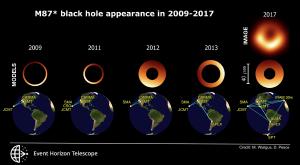Blog
Shadow Dancing
25 September 2020
 M. Wielgus, D. Pesce & the EHT Collaboration
M. Wielgus, D. Pesce & the EHT CollaborationIn April 2019, the Event Horizon Telescope (EHT) released the first direct image of a black hole. It was a radio image of the supermassive black hole in the galaxy M87. Much of the image resulted from radio light gravitationally focused toward us, but there was also some light emitted by gas and dust near the black hole. By itself, the image is a somewhat unimpressive blurry ring, but the data behind the image tells a more detailed story.1
Although named as a single telescope, the EHT is a collaboration of many radio observatories. Working together, they can act as a virtual telescope the size of Earth using a technique known as interferometry. Most of the black hole’s observational data has been gathered since 2017, but some of the observatories were making observations as far back as 2009. This means we have more than a decade’s worth of images, though the early images are much more blurry. But given what we now know about the black hole, those early observations can be analyzed in more detail, and the result is quite interesting.
If we could capture a perfect image of the black hole, it would appear as a thin ring of light. The ring is caused by general background light that is focused directly toward us. This light nearly grazes the black hole’s event horizon and gives us a measure of its mass. One side of the ring is always brighter than the other because of the black hole’s rotation. Light is given a boost of energy on the side rotating toward us, and thus appears brighter. If that ring of light were all we could see, then the black hole image would never change, since the black hole’s rotation is basically constant.
A decade’s worth of observation, however, shows that the ring does change over time. It is gradually wobbling, which means we also see material as captured by the black hole. The wobbling effect we see is caused by hot gas spiraling toward the event horizon. This is an exciting discovery because it will allow us to study how matter behaves close to a black hole. We will learn more about how black holes capture matter and how they can create relativistic jets. We could also find new ways to test general relativity.
In 2021 two more radio observatories will join the EHT, which will give us an even better look at the M87 black hole. As this latest result shows, there is still much we have to learn.
Maciek Wielgus, et al. “Monitoring the Morphology of M87* in 2009–2017 with the Event Horizon Telescope.” The Astrophysical Journal 901.1 (2020): 67 ↩︎